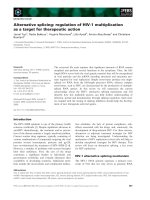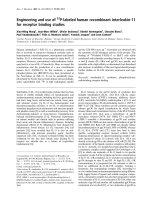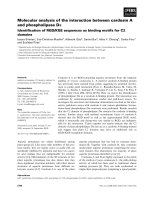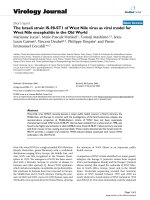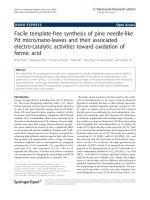Use of formic acid formates as hydrogen source for reactions
Bạn đang xem bản rút gọn của tài liệu. Xem và tải ngay bản đầy đủ của tài liệu tại đây (8.85 MB, 220 trang )
USE OF FORMIC ACID/FORMATES AS HYDROGEN
SOURCE FOR REACTIONS
GAO YANXIU
(B. Sc, Shandong University)
A THESIS SUBMITTED
FOR THE DEGREE OF DOCTOR OF PHILOSIPHY
DEPARTMENT OF CHEMISTRY
NATIONAL UNIVERSITY OF SINGAPORE
2014
Declaration
I hereby declare that this thesis is my original work and it has been written by
me in its entirety, under the supervision of Prof. Chuah Gaik Khuan, (in the
catalysis laboratory located at S5-04-04 and S5-02-02), Chemistry Department,
National University of Singapore, between August 2010 and July 2014.
I have duly acknowledged all the sources of information which have been used
in the thesis.
This thesis has also not been submitted for any degree in any university
previously.
The content of the thesis has been partly published in:
1) Yanxiu Gao, Stephan Jaenicke, Gaik-Khuan Chuah*, Highly efficient
transfer hydrogenation of aldehydes and ketones using potassium
formate over AlO(OH)-entrapped ruthenium catalysts, Appl. Catal. A:
Gen., 2014, 10.1016/j.apcata.2014.07.010
Gao Yanxiu
21/07/2014
Name
Signature
Date
i
Acknowledgement
First of all, I would like to express my deepest gratitude to my supervisor,
Associate Professor, Chuah Gaik Khuan, for giving me the opportunity to work
in her laboratory. Without her enthusiasm, guidance, patience and
understanding, this research work would not have been possible. I am also
grateful to Associate Professor, Stephan Jaenicke, for his invaluable advice and
guidance.
Appreciation also goes to my labmates particularly, Wang Jie, Fan Ao, Liu
Huihui, Toy Xiu Yi, Han Aijuan, Sun Jiulong, Parvinder Singh and Irwan
Iskandar Bin Roslan for their help and encouragement.
Special thanks to Madam Toh Soh Lian and Sanny Tan Lay San for their
consistent technical support.
Financial support for my research from National University of Singapore is
gratefully acknowledged.
Last but not least, I would like to thank my husband and my parents for
their understanding, encouragement and support.
ii
iii
Table of contents
PAGE
Acknowledgement
i
Table of contents
iii
Summary
ix
List of publications
xi
List of tables
xiii
List of figures
xv
List of schemes
xxi
Chapter 1 Introduction
1.1 General introduction
1
1.2 Catalytic hydrogen production from formic acid/formates
3
1.2.1 Homogeneous catalysis
5
1.2.2 Heterogeneous catalysis
9
1.3 Application of formic acid/formates for reactions
16
1.4 Transition metal based heterogeneous catalysts
21
1.4.1 Effect of particle size
21
1.4.2 Effect of support
22
1.4.3 Preparation of supported transition metal catalysts
24
1.5 Aims of the present study
27
References
29
Chapter 2 Experimental
iv
2.1 Catalyst preparation
39
2.1.1 Synthesis of AlO(OH)-entrapped metal catalysts
39
2.1.2 Synthesis of ZrO
2
-entrapped Ru catalysts
40
2.1.3 Synthesis of the amine-modified Ru/AlO(OH)
41
2.1.4 Synthesis of activated carbon supported Pd, Ru, Ag and
Pd-Ag catalysts
42
2.1.5 Synthesis of -Al
2
O
3
supported Pd and Ru catalysts
44
2.1.6 Synthesis of ZrO
2
supported Ru catalysts
44
2.2 Catalyst characterization
45
2.2.1 Powder x-ray diffraction
45
2.2.2 N
2
adsorption
46
2.2.3 Transmission electron microscopy
48
2.2.4 Thermogravimetric analysis
48
2.2.5 Inductively coupled plasma atomic emission spectroscopy
48
2.2.6 X-ray photoelectron spectroscopy
49
2.3 Catalytic experiments
50
2.3.1 Decomposition of formic acid
50
2.3.2 Hydrogenation of aldehydes and ketones
51
2.3.3 Hydrogenation of , -unsaturated carbonyl compounds
53
2.3.4 Hydrogenation of levulinic acid
54
References
56
Chapter 3 Hydrogen generation from formic acid
decomposition with potassium formate as the additive
3.1 Introduction
57
v
3.2 Results and discussion
60
3.2.1 Catalyst characterization
60
3.2.2 Decomposition of formic acid using formate as additive
62
3.2.3 Bimetallic Pd-Ag/C for decomposition of formic
acid/formate
69
3.2.4 Comparison with literature results
73
3.3 Conclusion
74
References
76
Chapter 4 Transfer hydrogenation of aldehydes using
potassium formate over AlO(OH)-supported palladium
catalysts
4.1 Introduction
79
4.2 Results and discussion
81
4.2.1 Catalyst characterization
81
4.2.2 Hydrogenation of benzaldehyde over Pd/AlO(OH)
85
4.2.3 Activity for various aldehydes
92
4.2.4 Comparison with literature results
94
4.3 Conclusion
96
References
97
Chapter 5 Highly efficient transfer hydrogenation of aldehydes
and ketones using potassium formate over AlO(OH)-supported
ruthenium catalysts
5.1 Introduction
101
vi
5.2 Results and discussion
103
5.2.1 Catalyst characterization
103
5.2.2 Hydrogenation of benzaldehyde over Ru/AlO(OH)
109
5.2.3 Activity for various aldehydes and ketones
121
5.3 Conclusion
126
References
127
Chapter 6 Highly efficient chemoselective transfer
hydrogenation of carbonyl groups over amine-modified
Ru/AlO(OH) catalysts
6.1 Introduction
129
6.2 Results and discussion
132
6.2.1 Catalyst characterization
132
6.2.2 Hydrogenation of cinnamaldehyde over Ru/AlO(OH)
143
6.2.3 Hydrogenation of cinnamaldehyde over amine-modified
Ru/AlO(OH)
151
6.2.4 Activity for various , -unsaturated carbonyl compounds
160
6.3 Conclusion
162
References
164
Chapter 7 Production of -valerolactone from the biomass-
derived levulinic acid and formic acid/formate over ZrO
2
-
supported ruthenium catalysts
7.1 Introduction
169
7.2 Results and discussion
172
vii
7.2.1 Catalyst characterization
172
7.2.2 Optimization of catalyst
180
7.2.3 Optimization of reaction condition
188
7.3 Conclusion
191
References
192
Chapter 8 Future work
8.1 To investigate the chemoselective reduction of nitro groups
195
8.2 Alternative metal to ruthenium
195
References
196
viii
ix
Summary
The catalytic transfer hydrogenation has emerged as an attractive alternative to
the hydrogenation using highly flammable molecular hydrogen. In catalytic
transfer hydrogenation, the reduction is carried out in the presence of a catalyst
using an organic/inorganic molecule as the hydrogen donor. Formic
acid/formates are favorable hydrogen donors, because they are stable and
readily available and catalytically easy to decompose to hydrogen gas and
carbon dioxide/bicarbonate. The objective of this thesis is to hydrogenate
carbonyl groups to corresponding alcohols using formic acid/formate as
hydrogen donors. Hydrogen generation from the decomposition of formic
acid/formate was first studied. Chemoselective hydrogenation of carbonyl
groups in the presence of other reducible groups, such as –Cl, –CN and C=C,
was then investigated by selecting an appropriate metal and modifying the
catalyst support. The study also looked into the catalyst stability and reusability.
It was found that the hydrogen evolution from formic acid decomposition
was slow in aqueous solution without any additives. Formates are favorable
additives due to their high stability and solubility in water which facilitates the
reaction processing and catalyst recycling. In this study, potassium formate was
used as an additive and the effect of molar ratio for formic acid : formate was
investigated.
The reduction of aldehydes and ketones to corresponding alcohols was
investigated using potassium formate as the hydrogen source. The catalysts used
were Pd/AlO(OH) and Ru/AlO(OH) prepared by a sol gel process. It was found
that aromatic aldehydes easily undergo reduction to alcohols while aliphatic
x
aldehydes and ketones are less reactive due to electronic and steric effect,
respectively. For the Pd/AlO(OH), 4-chloro-benzaldehyde was dehalogenated
to benzaldehyde followed by hydrogenated to benzyl alcohol. Using the
Ru/AlO(OH), the hydrogenation of 4-chlorobenzaldehyde proceeded with
excellent chemoselectivity for the reduction of C=O groups with 4-chlorobenzyl
alcohol as the only product.
The hydrogenation of -unsaturated carbonyl compounds to
corresponding allylic alcohols using potassium formate was next studied. While
the Ru/AlO(OH) was not chemoselective to C=O groups, forming saturated
aldehydes/ketones as the only products, the catalyst became highly
chemoselective after the support was modified by grafting with 3-(2-
aminoethylamino)propyltrimethoxysilane. High yields of allylic alcohols, > 95
%, were obtained. In this study, we were interested in evaluating the role of
amino groups in directing chemoselectivity when -unsaturated carbonyl
compounds were reduced to allylic alcohols.
The production of -valerolactone, a sustainable liquid for carbon-based
chemicals for energy, from biomass-derived levulinic acid and formic acid was
reported. The use of formic acid as the hydrogen donor is attractive because an
equimolar amount of formic acid is formed during the production of levulinic
acid from carbohydrates. The catalyst, 2.5 wt. % Ru/ZrO
2
, was prepared by a
sol gel method. The catalyst was optimized by investigating the effect of
support, metal loading and calcination temperature. The reaction condition was
studied in detail for the variation of the molar ratio for formic acid/formate as
well as hydrogen source/LA.
xi
List of Publications
Journal paper
1. Yanxiu Gao, Stephan Jaenicke, Gaik-Khuan Chuah
Highly efficient transfer hydrogenation of aldehydes and ketones using
potassium formate over AlO(OH)-entrapped ruthenium catalysts
Appl. Catal. A: Gen., 2014, 10.1016/j.apcata.2014.07.010
Conference papers
1. Yanxiu Gao, Stephan Jaenicke, Gaik-Khuan Chuah
Highly efficient and chemoselective reduction of aldehydes with
supported ruthenium catalyst under transfer hydrogenation conditions
(Poster presentation at the 6
th
Asia-Pacific Congress on Catalysis, 13-17
October 2013)
2. Yanxiu Gao, Stephan Jaenicke, Gaik-Khuan Chuah
Highly chemoselective transfer hydrogenation of aldehydes using
potassium formate over heterogeneous ruthenium catalyst
(Poster presentation at the 7
th
Singapore International Chemical
Conference, 16-19 December 2012)
xii
xiii
List of tables
PAGE
Table 1-1 Hydrogen density for formic acid/formates 3
Table 1-2 Comparison of properties: methanol versus formic acid [8] 4
Table 1-3 Formic acid decomposition over homogeneous catalysis (modified
from ref. [7]) 8
Table 1-4 Formic acid decomposition over heterogeneous catalysts 14
Table 1-5 Most widely used hydrogen donor compounds 20
Table 2-1 Composition control in preparing 1 g PdAg
x
/C 43
Table 3-1 Metal composition and crystallite size of the catalysts 61
Table 3-2 Effect of HCOOK/HCOOH on the H
2
generation 64
Table 3-3 Effect of the reaction temperature on the hydrogen evolution 67
Table 3-4 Comparison of the PdAg
x
/C with the 1 wt. % Pd/C on the hydrogen
generation rate 71
Table 4-1 Textural properties of catalysts 82
Table 4-2 Effect of the palladium loading on transfer hydrogenation of
benzaldehyde 86
Table 4-3 Catalytic transfer hydrogenation of various aldehydes over 1 wt. %
Pd/AlO(OH) 93
Table 4-4. Comparison with literature results for the reduction of
benzaldehyde 95
Table 5-1 Textural properties of catalysts 107
Table 5-2 Catalytic transfer hydrogenation of benzaldehyde over different
catalyst 111
Table 5-3 Effect of Ru loading on transfer hydrogenation of benzaldehyde 111
Table 5-4 Catalytic transfer hydrogenation of various aldehydes over 1 wt. %
Ru/AlO(OH) 122
xiv
Table 5-5 Catalytic transfer hydrogenation of various ketones over 2 wt. %
Ru/AlO(OH) 125
Table 6-1 Textural properties of the amine-grafted Ru/AlO(OH) 134
Table 6-2 Ruthenium and nitrogen composition for the amine-grafted 1 wt. %
Ru/AlO(OH) 140
Table 6-3 Effect of Ru loading on the transfer hydrogenation of
cinnamaldehyde 145
Table 6-4 Effect of the EDA/Ru on the transfer hydrogenation of
cinnamaldehyde 149
Table 6-5 Hydrogenation of cinnamaldehyde over 1 wt. % Ru/AlO(OH)
modified with different amine 153
Table 6-6 Hydrogenation of cinnamaldehyde over amine 2-modifed
Ru/AlO(OH) 156
Table 6-7 Ruthenium and nitrogen compositions for the 2-1 wt. % Ru-6 before
and after reaction 159
Table 6-8 Hydrogenation of various -unsaturated carbonyl compounds162
Table 7-1 Textural properties for the 2.5 wt. % Ru on different support and
ZrO
2
-supported different metal 173
Table 7-2 Textural properties for Ru/ZrO
2
samples 174
Table 7-3 Textural properties for 2.5 wt. % Ru/ZrO
2
calcined at different
temperature 176
Table 7-4 Catalytic hydrogenation of levulinic acid over different catalyst 184
Table 7-5 Effect of the formic acid/potassium formate on levulinic acid
hydrogenation 189
xv
List of figures
PAGE
Fig. 1-1 Cycle for hydrogen storage in (a) formic acid [8] and (b) formates
[15] 3
Fig. 1-2 Synthetic process for gold nanoparticles embedded inside spheres
with double or single shells [127] 26
Fig. 1-3 TEM images of Au/AlO(OH): (a) high resolution, (b) low resolution,
(c) Au particle size distribution [128] 26
Fig. 2-1 Amine precursors used to form amine-modified Ru/AlO(OH) 42
Fig. 2-2 Setup for the decomposition of formic acid 51
Fig. 2-3 Gas chromatogram for the hydrogenation of cinnamaldehyde 54
Fig. 3-1 Density functional theory optimized structures for key adsorbed
states. (a) HCOOH-(H
2
O)
4
adsorption in the O-down configuration; (b)
HCOOH-(H
2
O)
4
in the CH-down configuration. [10, 11] 59
Fig. 3-2 XRD diffractograms for (a) activated carbon, (b) 1 wt. % Pd/C, (g) 1
wt. % Ag/C and PdAg
x
/C with Ag/Pd molar ratio of (c) 0.5, (d) 1, (e) 1.5 and
(f) 2. (Dashed line and solid line denote standard (111) peak positions of bulk
Ag and Pd, respectively.) 62
Fig. 3-3 Kinetic profile for the formic acid decomposition reaction with
different HCOOK/HCOOH molar ratio 65
Fig. 3-4 Effect of the HCOOK/HCOOH on the initial TOF and the conversion
after 5 h 66
Fig. 3-5 Reusability of the 1 wt. % Pd/C. Reaction conditions: formic acid (1.8
mmol) and potassium formate (0.2 mmol) in 2 mL H
2
O, 50 mg catalyst, 60
oC, under N
2
, 5 h 68
Fig. 3-6 Initial TOFs for reuse runs over the 1 wt. % Pd/C 68
Fig. 3-7 XRD diffractograms for the 1 wt. % Pd/C (a) fresh and (b) after 4
runs 69
Fig. 3-8 Kinetic profile for the formic acid decomposition over PdAg
x
/C
catalysts with different Ag/Pd molar ratio. Reaction conditions: formic acid
xvi
(0.9 mmol) and potassium formate (0.1 mmol) in 1 mL water, 50 mg PdAg
x
/C,
25 °C, under N
2
71
Fig. 3-9 Reusability of the PdAg
1
/C. Reaction conditions: formic acid (1.8
mmol) and potassium formate (0.2 mmol) in 2 mL water, 50 mg PdAg
1
/C, 60
o
C, under N
2
72
Fig. 3-10 Initial TOFs for reuse runs over the PdAg
1
/C 73
Fig. 3-11 XRD diffractograms for the PdAg
1
/C (a) fresh and (b) after 6 runs73
Fig. 4-1 (a) Nitrogen adsorption-desorption isotherms and (b) pore size
distribution for Pd/AlO(OH) with different Pd loading 83
Fig. 4-2 XRD diffractograms for (a) AlO(OH) and Pd/AlO(OH) with (b) 0.5
(c) 1 (d) 1.5 (e) 2 and (f) 4 wt. % Pd 84
Fig. 4-3 TEM images and particle size distribution for (a) 1 wt. %
Pd/AlO(OH) and (b) 1 wt. % Pd/AlO(OH) after 5 runs 84
Fig. 4-4 (a) N
2
adsorption-desorption isotherms and (b) pore size distribution
for fresh and used 1 wt. % Pd/AlO(OH) with and without washing with water
and ethanol 88
Fig. 4-5 Catalytic transfer hydrogenation of benzaldehyde using different
H
2
O/HCOOK molar ratio. Reaction conditions: 1 mmol benzaldehyde, 3
mmol HCOOK, 5 mL ethanol, 50 mg 1 wt. % Pd/AlO(OH), 45 C, N
2
89
Fig. 4-6 Initial rate for transfer hydrogenation of benzaldehyde versus
H
2
O/HCOOK molar ratio 90
Fig. 4-7 Catalytic transfer hydrogenation of benzaldehyde using different
HCOOK/benzaldehyde molar ratio. Reaction conditions: 1 mmol
benzaldehyde, H2O/HCOOK molar ratio constant at 4, 5 mL ethanol, 50 mg 1
wt. % Pd/AlO(OH), 45 C, N
2
91
Fig. 4-8 Initial rate for transfer hydrogenation of benzaldehyde versus the
HCOOK/benzaldehyde molar ratio 91
Fig. 4-9 Kinetic profile for the transfer hydrogenation of 4-chloro-
benzaldehyde 94
Fig. 5-1 XRD diffractograms for (a) AlO(OH) and Ru/AlO(OH) with (b) 0.5
(c) 1 (d) 2 (e) 5 (f) 8 and (g) 10 wt. % Ru 104
Fig. 5-2 TEM images and particle size distribution for (a) 1 and (b) 10 wt. %
Ru/AlO(OH) 104
xvii
Fig. 5-3 (a) Nitrogen adsorption-desorption isotherms and (b) pore size
distribution for Ru/AlO(OH) with different Ru loading 108
Fig. 5-4 TGA (solid lines) and derivative weight loss (dashed lines) profiles of
(a) AlO(OH) and Ru/AlO(OH) with (b) 1 (c) 2 (d) 5 (e) 8 and (f)10 wt. % Ru
109
Fig. 5-5 X-ray diffractograms for AlO(OH) (a) as-prepared and after
calcination at (b) 300 C, (c) 400 C and (d) 500 C 109
Fig. 5-6 Reaction profiles for transfer hydrogenation of benzaldehyde over
Ru/AlO(OH) with different Ru loading 112
Fig. 5-7 Catalytic transfer hydrogenation of benzaldehyde for (○) as-prepared
1 wt. % Ru/AlO(OH) and after hydrogen pretreatment for 1 h at (●) 150 C
and (▲) 300 C 113
Fig. 5-8 XPS spectrum for the 5 wt. % Ru/AlO(OH) (a) as-prepared and (b)
reduced at 300 ºC showing C 1s (purple), Ru
o
(green) and Ru
+
(red) 113
Fig. 5-9 (a) N
2
adsorption-desorption isotherms and (b) pore size distribution
of fresh and used 1 wt. % Ru/AlO(OH) with and without washing with water
and ethanol 115
Fig. 5-10 Reuse of the 1 wt. % Ru/AlO(OH) for hydrogenation of
benzaldehyde 116
Fig. 5-11 Hot filtration tests during transfer hydrogenation of benzaldehyde
for (▲∆) 1 wt. % Ru/AlO(OH) (50 mg) and (●○) 1 wt. % Ru/Al
2
O
3
(100 mg)
prepared by wet impregnation 116
Fig. 5-12 Transfer hydrogenation of benzaldehyde using H
2
O/HCOOK molar
ratio of (a) 0 to 5 and (b) 6 and 7. Reaction conditions: 1 mmol benzaldehyde,
3 mmol HCOOK, 5 mL DMF, 100 mg 1 wt. % Ru/AlO(OH), 100 C, N
2
118
Fig. 5-13 Dependence of initial rate for transfer hydrogenation of
benzaldehyde on H
2
O/HCOOK molar ratio 119
Fig. 5-14 Transfer hydrogenation of benzaldehyde using different
HCOOK/benzaldehyde molar ratio. Reaction conditions: 1 mmol
benzaldehyde, H
2
O/HCOOK constant at 5, 5 mL DMF, 100 mg 1 wt. %
Ru/AlO(OH), 100 C, N
2
120
Fig. 5-15 Dependence of initial rate for transfer hydrogenation of
benzaldehyde on HCOOK/benzaldehyde molar ratio 120
Fig. 5-16 Kinetic profile for the transfer hydrogenation of 4-chloro-
benzaldehyde 123
xviii
Fig. 6-1 Amines used to form amine-modified Ru/AlO(OH) 132
Fig. 6-2 N
2
adsorption-desorption isotherms (a) and pore size distribution (b)
for amines 1, 2 and 3-grafted 1 wt. % Ru/AlO(OH) with an amine/Ru constant
at 6 135
Fig. 6-3 N
2
adsorption-desorption isotherms (a) and pore size distribution (b)
for the amine 2-grafted 1 wt. % Ru/AlO(OH) with different amine 2/Ru molar
ratio 136
Fig. 6-4 N
2
adsorption-desorption isotherms (a) and pore size distribution (b)
for the amine 2-grafted Ru/AlO(OH) with different Ru loading at an amine/Ru
of 6 137
Fig. 6-5 TEM images and particle size distribution for amine 2 grafted- (a) 1
and (b) 10 wt. % Ru/AlO(OH) with amine/Ru constant at 6 138
Fig. 6-6 XRD diffractograms for (a) 1 wt. % Ru/AlO(OH) and amine 2-grafted
1 wt. % Ru/AlO(OH) with different amine 2/Ru molar ratio of (b) 1, (c) 2, (d)
4, (e) 6 and (f) 8 139
Fig. 6-7 XPS spectra for the amine 2-modified AlO(OH) support 141
Fig. 6-8 XPS spectra for the amine 2-modified 1 wt. % Ru/AlO(OH) with the
amine 2/Ru molar ratio of (a) 1, (b) 2, (c) 4 and (d) 6 142
Fig. 6-9 XPS spectra for 1 wt. % Ru/AlO(OH) grafted with (a) amine 1, (b)
amine 2 and (c) amine 3 142
Fig. 6-10 Kinetic profile for the transfer hydrogenation of cinnamaldehyde
over Ru/AlO(OH) with Ru loading of (a) 1, (b) 2, (c) 5, (d) 8 and (e) 10 wt. %.
(♦) cinnamaldehyde conversion; selectivity to (●) cinnamyl alcohol, (▲) 3-
phenylpropanal and (○) 3-phenylpropanol 146
Fig. 6-11 Effect of the EDA/Ru molar ratio on the (a) kinetic profile and (b)
cinnamyl alcohol selectivity in the transfer hydrogenation of cinnamaldehyde
over 1 wt. % Ru/AlO(OH) 150
Fig. 6-12 Leaching test for the transfer hydrogenation of cinnamaldehyde over
1 wt. % Ru/AlO(OH) at an EDA/Ru of 2 151
Fig. 6-12 Reaction profile for the transfer hydrogenation of cinnamaldehyde
over the amine (a) 1, (b) 2 and (c) 3 grafted-1 wt. % Ru/AlO(OH) at constant
amine/Ru molar ratio of 6. (♦) cinnamaldehyde conversion; selectivity to (●)
cinnamyl alcohol, (▲) 3-phenylpropanal and (○) 3-phenylpropanol 154
Fig. 6-14 Reaction profile for the transfer hydrogenation of cinnamaldehyde
over the amine 2-grafted 1 wt. % Ru/AlO(OH) with the 2/Ru molar ratio of (a)
xix
1, (b) 2, (c) 4, (d) 8. (♦) cinnamaldehyde conversion; selectivity to (●)
cinnamyl alcohol, (▲) 3-phenylpropanal and (○) 3-phenylpropanol 157
Fig. 6-15 Reusability of the 2-1 wt. % Ru-6 in the transfer hydrogenation of
cinnamaldehyde using potassium formate 160
Fig. 7-1 (a) Nitrogen adsorption-desorption isotherms and (b) pore size
distribution for Ru/ZrO
2
samples with different Ru loading 175
Fig. 7-2 (a) Nitrogen adsorption-desorption isotherms and (b) pore size
distribution for 2.5 wt. % Ru/ZrO
2
calcined at different temperature 177
Fig. 7-3 XRD diffractograms for the supported 2.5 wt. % Ru on (a) ZrO
2
, (b)
TiO
2
and (c) Al
2
O
3
. (The dashed lines denote the standard (110) and (101)
peak positions for the bulk RuO
2
, respectively.) 178
Fig. 7-4 XRD diffractograms for the (a) ZrO
2
and Ru/ZrO
2
with (b) 1, (c) 2,
(d) 2.5, (e) 3, (f) 5, (g) 8 and (h) 10 wt. % Ru. (The red and green dashed lines
denote the standard peak positions for the tetragonal and monoclinic ZrO
2
,
respectively.) 179
Fig. 7-5 XRD diffractograms for the (a) as-prepared 2.5 wt. % Ru/Zr(OH)
4
and 2.5 wt. % Ru/ZrO
2
calcined at (b) 300 ºC, (c) 400 ºC, (d) 500 ºC, (e) 600
ºC and (f) 700 ºC 180
Fig. 7-6 Calibration curve for levulinic acid 181
Fig. 7-7 Calibration curve for formic acid 182
Fig. 7-8 Calibration curve for GVL using DME as an external standard 182
Fig. 7-9 Effect of Ru loading for Ru/ZrO
2
catalysts on levulinic acid
hydrogenation. Reaction conditions: 5 mmol LA, 2.5 mmol formic acid, 2.5
mmol potassium formate, 12 mL H
2
O, 0.5 g catalyst , 150 ºC, 1 atm He, in 25
mL autoclave, 12 h 185
Fig. 7-10 Effect of the calcination temperature on textural properties and
levulinic acid hydrogenation. Reaction conditions: 5 mmol LA, 2.5 mmol
formic acid, 2.5 mmol potassium formate, 12 mL H
2
O, 0.5 g 2.5 wt. %
Ru/ZrO
2
, 150 ºC, 1 atm He, in 25 mL autoclave, 12 h 186
Fig. 7-11 Concentration versus time in the hydrogenation of LA. Reaction
conditions: 5 mmol LA, 2.5 mmol formic acid, 2.5 mmol potassium formate,
12 mL H
2
O, 0.5 g 2.5 wt. % Ru/ZrO
2
(0.025 mmol Ru, S/C of 40), 150 ºC, 1
atm He, in 25 mL autoclave, 12 h 187
Fig. 7-12 Effect of the pH of the reaction solution on levulinic acid
hydrogenation 190
xx
Fig. 7-13 Effect of hydrogen source/LA on LA reduction. Reaction conditions:
5 mmol LA, formic acid/formate constant at 1/1, 12 mL H
2
O, 0.5 g 2.5 wt. %
Ru/ZrO
2
(0.025 mmol Ru, S/C of 40), 150 ºC, 1 atm He, in 25 mL autoclave,
12 h 191
xxi
List of schemes
Scheme 6-1 Reaction pathways in the hydrogenation of cinnamaldehyde 143
Scheme 7-1 Catalytic conversion of hexoses into levulinic acid and the
hydrogenation platform of levulinic acid 170
xxii
1
Chapter 1
Introduction
1.1 General introduction
Nowadays, one of the most important challenges for our society is to develop
efficient methods for energy production and utilization to replace fossil fuels.
Several approaches have been introduced, such as solar energy, wind energy
and energy from biomass [1, 2]. However, the issue of energy storage has to be
resolved for large-scale use of solar and wind power while the low efficiency
(theoretically about 4.5 %) of photosynthesis in biomass is a key limiting factor
in providing a viable energy use and management. Hydrogen has been proposed
as an excellent energy carrier mainly because it is light and clean [3]. The stored
energy can be easily utilized by reacting hydrogen with oxygen, for example in
fuel cells. Advantageously, only water is formed as a side product. Production
and storage are the main issues when using hydrogen as the energy carrier. The
existing large-scale production of hydrogen is mainly from steam reforming of
methane or the water gas shift reaction (WGSR) [4-6]. Nevertheless, these
processes need fossil fuels as feed and the removal of carbon monoxide requires
special purification. Several hydrogen storage concepts have been proposed,
such as tank systems and materials based on chemisorption and physisorption
of hydrogen. However, they have drawbacks such as low storage density, the
requirement of high-pressure apparatus, high temperature for hydrogen release
and safety issues [7].
